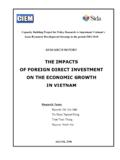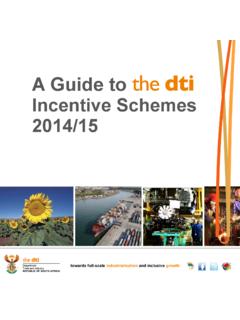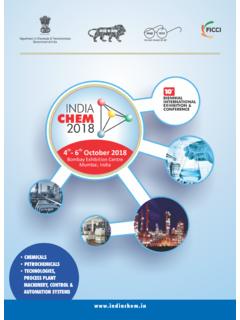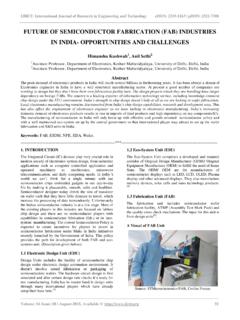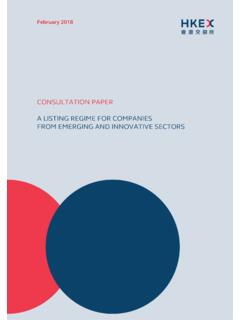Transcription of IRISH ICT CLUSTER - OECD.org
1 OECD CLUSTER Focus Group WorkshopUtrecht, May 8-9 2000 IRISH ICT CLUSTERRoy GreenNational University of Ireland, Ireland has one of the highest concentrations of information andcommunications technology (ICT) activity and employment in the OECD. This activitycomprises both electronics hardware manufacturing, such as PCs, and softwareproducts and services, especially business application products and localisation . Ithas largely been driven by foreign direct investment (FDI), though recent evidencesuggests that the indigenous software industry is now growing at a much faster ratethan the multinational sector. It is also a major factor in high skill, high wage jobcreation since the early 1990s and comprises a key element of Ireland s nationalinnovation system . This paper identifies some potential areas for research on clusterdevelopment and & trade performanceOver the last decade, Ireland has experienced the fastest growth rate of output andemployment of any country in the OECD, with the number of jobs across theeconomy increasing by 42 per cent between 1990-99 (see Figure 1).
2 While theservices sector was the main source of this increase, manufacturing employment alsogrew rapidly, for the most part in high value adding, knowledge based activities (seeFigure 2). The scale and composition of this growth have given rise to the term Celtictiger , and initial doubts about its sustainability have been met with evidence of far-reaching cumulative structural change and growth is essentially export led, with over 90 per cent of GDP sold abroad andan average increase in export volumes of more than 12 per cent a year during the1990s. Ireland has consistently recorded a trade surplus over this period in excess of10 per cent of GNP, primarily due to the impetus provided by a large, globalised andincreasingly sophisticated ICT sector. Recent OECD data indicates that Ireland hasthe highest proportion of high technology industries represented in its manufacturingexports of all OECD countries (OECD 1999).
3 2 Electronics accounts for more than a third of IRISH exports, with a third of the PCs soldin Europe manufactured in Ireland. In addition, Ireland is now the biggest exporter ofsoftware products in the world, having just overtaken the US. Over 40 per cent ofpackaged software and 60 per cent of business application software sold in Europe isproduced in Ireland. International demand is the main factor in continuing exportgrowth not only for multinational companies in Ireland but also for the indigenoussoftware industry which exports almost 60 per cent of its output (Travers 1999).Foreign direct investmentHowever, the key driver of Ireland s trade performance has been FDI, which accountsfor two thirds of manufacturing output and over 80 per cent of manufacturing 1998, Ireland attracted FDI inflows of $ billion, which makes it one of onlyfour countries in the OECD along with Finalnd, Sweden and the Netherlands where FDI amounts to more than 8 per cent of GDP.
4 Moreover, with only 1 per centof the EU population, Ireland gained 23 per cent of all FDI projects in Europe in1997,covering manufacturing, software, teleservices and shared services computer software, Ireland has the largest market share of FDI in Europe with 55per cent of the total, more than twice the market share of the next most successfulcountry (France at 21 per cent). Similarly, Ireland s market share of FDI inteleservices (over 28 per cent in 1994-97) and in shared services such as back officeactivities (37 per cent over 1996-97) is also the highest in Europe. In electronics,Ireland s market share is second only to the UK at around 22 per cent, and the gap isclosing (see Figure 3). In the manufacturing sector too, Ireland s market share of FDIincreased to 13 per cent of the total by 1997, behind the UK and France. 19 of the top25 computer firms in the world have manufacturing operations in characteristicsIreland s ICT activities were mainly characterised at the initial stages of developmentby manufacture and assembly of electronics hardware, but this is rapidly beingovertaken by more complex integrated manufacturing and software operations,including those of the indigenous software industry as assembly operations relocate tolow labour cost countries.
5 During the 1990s, indigenous firms achieved growth ratesof 11 per cent a year for employment, 25 per cent a year for the value of sales andalmost 40 per cent a year for the value of exports. While the electronics sectorcontinues to be dominated by large multinational companies, employment in softwareproducts and services is more evenly divided between overseas and indigenouscompanies, mainly of the software multinationals in Ireland are packaged software or productcompanies selling to mass markets, though the growing emphasis on localisationrequires a higher level of software engineering skills and is more reliant onoutsourcing and indigenous supply chains, including translation, fulfilment,packaging, manual printing, transport and technical support (see Figure 4). Irishpublic policy has recognised that the full benefit of the presence of foreignproduction firms depends on the extent to which they can be integrated into theirenvironment.
6 Such relationships are not only beneficial for local suppliers that benefitfrom technology Foreign firms will be anchored to the regional economy,3merging local and global interests, and making sudden divestiture less likely thanbefore (OECD 1998a).As a result, indigenous software producers tend to be more specialised in terms ofboth types of products and types of customers. According to a recent survey, half ormore of the sales of about a third of these firms go to the IRISH subsidiaries ofmultinationals (O Gorman 1997). However, a further third have little or no linkagewith the multinational sector and have targeted niche markets both locally andglobally. Indigenous firms also provide software services such as programmedevelopment, consultancy and technical training, which tends in many case to lead tothe development of new software products. IRISH software start-ups, particularly IonaTechnology, Smartforce, Baltimore Technology and Riverdeep, have contributed tothe critical mass achieved by the industry, but they have now been joined by anarray of dynamic new operators such as Datalex, Flexicom, Piercom, ManagedSolutions Corporation and Peregrine concentrationWhile manufacturing employment in general is widely dispersed in Ireland, thesoftware industry is concentrated largely in the Dublin area, with smaller regionalclusters in Cork, Limerick/Shannon and Galway (see Figure 5).
7 The CLUSTER dynamicis supplied in each case by a mix of inter-firm collaboration, interaction and rivalry,by the development and constant replenishment of common pools of skilled labour,by the localised support of research and educational institutions and by the strategiesof national and regional development dynamic broadly follows the pattern identified by previous OECD researchwhich found that industrial clusters with links to local and regional innovationnetworks have been associated with accelerated diffusion of technology and know-how. The pace at which technologies are diffused within national innovation systemsdepends on the country s industrial structure and technological specialisation,institutional set-up, corporate governance regimes, degree of economic openness andthe flexibility of firms organisational and managerial structures (OECD 1997). Inorder to test this observation further, the research proposed here will include adetailed case study of the Galway ICT & developmentDespite Ireland s strong ICT export performance, its dependence on FDI has alsobeen associated with the use of imported rather than locally generated is reflected in the very large deficit in Ireland s technology balance ofpayments , which measures flows in knowledge and disembodied technologiesbetween countries (see Figure 6).
8 It is compounded by Ireland s comparatively low R& D intensity, as indicated by its low level of business expenditure on R & D as aproportion of GDP (at per cent). It has only been with the growth of theindigenous software industry that this problem is being addressed. R & D businessexpenditure as a proportion of GDP has more than doubled over the past decade withindigenous software companies allocating more than 10 per cent of the value of salesin 1995 (National Software Directorate 1996), and almost 20 per cent among thosecompanies that actually performed R & increased emphasis on R & D is supported by a substantial influx of third levelgraduates into the ICT sector, most with qualifications in computer science andengineering, and a huge expansion of Government research funding as part of theNational Development Plan 2000-2006. The Government s Research, TechnologicalDevelopment and Innovation (RTDI) strategy is based on the recognition that there isa strong link between investment in the research and innovation base of the economyand sustained economic [T]he accumulation of knowledge capital.
9 Willfacilitate the evolution of the knowledge-based economy (para ). Its objectivesare to: develop intellectual infrastructure to root overseas companies herethrough more extensive use of research based in Ireland, persuade and encourage companies to develop their own researchactivities, develop a world class research environment in our higher educationinstitutions and State research institutions, and ensure a vibrant and dynamic pool of high quality, technically literategraduates from the graduate to postdoctoral levels to service the needs ofthese companies and to start their own companies (para ).Policy structuresThe evolution of Ireland s ICT sector has been driven not only by market conditionsbut by the conscious design and delivery of public policy over a number of decades inthe context of EU membership and, more recently, social partnership (O Donnell2000).
10 This has compised measures to attract knowledge intensive FDI through IDAI reland, support for indigenous companies and networks through Enterprise Ireland,promotion of education and training at all levels, especially universities and technicalcolleges, development of a sophisticated telecommunications infrastructure, increasedfunding support for research in third level institutions and strengthened linkagesbetween companies and the education s human resource base has been a key factor in the creation of competitiveadvantage for its ICT industries. In the most recent IMD World CompetitivenessReport (1998), Ireland was ranked first in the world for the fit between itseducational system and the needs of a competitive economy (see Figure 7). Certainly,Ireland s economic transformation is evidence that past national strategies forinvesting in education and training have paid off in terms of faster productivitygrowth and higher levels of productivity at the aggregate level, and higher earningsand employability at the individual level (OECD 1998b).










